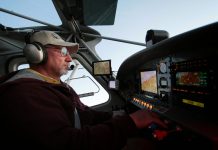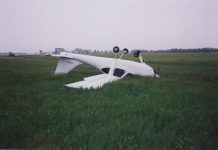Can you imagine that? I was hit with this question after I returned from Oshkosh.
 And that question was from an underwriter no less. Pilots, as aviation fanatics, know that aviation is safe. We tell ourselves that every time we climb into the cockpit. And when you look at the statistics, the numbers show that, overall, aviation is a safe mode of transportation. Just look at the miles flown and the number of passengers that travels on airlines. You know, I actually think that if the majority of the non-aviating public really knew the truth about general aviation, they would all be flocking to the local FBO asking (or begging) to learn how to fly. Me, I’ve been flying the airlines to a number of the shows. (I actually practice what I preach in my seminars. And sometimes the airline industry can provide better service for my needs than flying a private plane). Yes I agree, that it is a terrible thing for a private pilot to say (and do), and no, I don’t always like it. But economics and business sense support the airlines on some occasions. In fact, every flight this year has been delayed for hours (or overnight) and two of my three arrivals back home were without my checked baggage. And I have e-mailed my wife numerous times from my iPhone, asking her to remind me why I was on an airline! But, I do believe in using and supporting “all” of aviation. It’s in the best interest of all pilots.
And that question was from an underwriter no less. Pilots, as aviation fanatics, know that aviation is safe. We tell ourselves that every time we climb into the cockpit. And when you look at the statistics, the numbers show that, overall, aviation is a safe mode of transportation. Just look at the miles flown and the number of passengers that travels on airlines. You know, I actually think that if the majority of the non-aviating public really knew the truth about general aviation, they would all be flocking to the local FBO asking (or begging) to learn how to fly. Me, I’ve been flying the airlines to a number of the shows. (I actually practice what I preach in my seminars. And sometimes the airline industry can provide better service for my needs than flying a private plane). Yes I agree, that it is a terrible thing for a private pilot to say (and do), and no, I don’t always like it. But economics and business sense support the airlines on some occasions. In fact, every flight this year has been delayed for hours (or overnight) and two of my three arrivals back home were without my checked baggage. And I have e-mailed my wife numerous times from my iPhone, asking her to remind me why I was on an airline! But, I do believe in using and supporting “all” of aviation. It’s in the best interest of all pilots.
Leave it to an underwriter. Just when you think it is safe to go back into the air, they throw out some type of a common sense question.
But, the question of safety touched a nerve. For once it was the reverse of a normal conversation with a non-flying person. Usually the question is “how safe”, not is it “too safe”! All we usually see is the accidents that make the news. What we, the pilots of today, want the general public to see is the excitement, the freedom, the utility AND the safety.
Remember that anonymous quote on the walls of many airport lobbies, “Flying isn’t inherently dangerous, crashing is.” That’s the importance of educating the non-flying public. Flying is a safe. But still, too safe?
So anyway, why are we talking about safety and being too safe? A while ago I was trying to get a few of the underwriters that I work with to think about putting very low time and/or student pilots in custom planes. We had discussed the situation before but I was still having difficulty achieving the goal. Some of the underwriters still believe that students should not be in experimental aircraft along with pilots less than 100 hours total time. I have insured new pilots and non-pilots in experimental aircraft but it is always a big hassle. The underwriters are looking for training programs or they want the students to get a lot of hours in a factory aircraft first.
Putting a student or low time pilot in a new experimental is not always feasible. For example, a student in an aircraft that has restrictions to fly off. Usually no passengers are allowed and the instructor could be deemed a passenger. Sure the comment is “necessary crew”, but the FAA doesn’t usually consider the instructor necessary for the flight-testing phase of the aircraft.
I also noticed a few magazines have been talking about the advantages of building your own aircraft and getting lessons in that same aircraft. That sounds like a great way to save a few bucks in the pursuit of the private pilot license, but if you need to have insurance…rent first. And then there is the Sport Category, which could put new low time pilots with very little training into a previously experimental, but now FAA certified, aircraft. What happens to the insurance in those instances?
So I started a personal quest. I wanted the underwriters that I work with to experience flying an aircraft that I felt was a good candidate for the low time pilot. It already had an experimental version and a certified version to compare. They, the underwriters, had already told me that if the aircraft was certified they would probably insure a student in the aircraft. I assumed that meant the basic criteria was based on the certification. A side note here. I think there is a little more to it than that. My feeling is that every flight in an experimental is a test flight. Yes, that Wing Ding 2000 may be a tested design, but compared to a factory built aircraft, they are not consistently produced. They can’t be. They don’t meet the same guidelines and requirements as a factory aircraft. Builders with different skills and talents will finish each experimental aircraft, even with a quick built kit.
Because of that, putting new or low time pilots in an experimental can increase the risk. Not only could the aircraft be new and inexperienced, so could the pilot.
So a few years back at Oshkosh, we set up a couple of flights. I chose the Symphony (certified) aircraft and the Glastar (the experimental equivalent). This is not about which aircraft is better. It is not about what the differences are between the two aircraft. This is about the fact that the underwriters said they would be more apt to insure a student in a Symphony than in a Glastar. And of course I said…why? So that meant they needed to fly the Glastar. If they would insure the Symphony because of the certification, they didn’t even need to fly that aircraft. Hence, the demo flights for underwriter in an experimental aircraft.
Flight of the underwriter
Having an underwriter fly an aircraft is not going to necessarily change a thing. It could backfire and make them hate the aircraft even worse. But I figure anything to help them understand the characteristics of a specific model can’t hurt. And I figured that if the underwriter can experience the behavior of the aircraft in the hands of a pilot that really knows the airplane they might change their minds. So at Oshkosh, the underwriters flew the Glastar. The Glastar, in the right hands, is a very capable aircraft. It is an aircraft that can make learning to fly very easy. It was able to make 30 and 60-degree banks with my feet on the floor and my hands in my lap. Not only that, but it makes a switch from left to right 60 degree banks with the touch of a finger. And if that is not enough, it was able to fly cross controlled in a stall condition without stalling.
Now, in my opinion, the Glastar could make a good aircraft for a lower time or student pilot. I’m looking at it from an agent’s view and an FBO background.
Would I be willing to rent an aircraft like the Glastar to a student pilot? Was it as good as the venerable Cessna 150? I think so. It actually seemed easier to fly than the 150…and that is tough to accomplish.
BUT…the opinions are still out from the underwriters. Yes, they had a great flight and they do think the aircraft is good. And in fact we are getting lower time pilots in the aircraft. Each quote is a case-by-case basis, and I admit that the questions from the underwriters were very good. Very specific. While they agreed that the aircraft handled very well during those special times (you know, slow flight, approach to landings and cross controlled) they felt the aircraft might train pilots that are too “safe”?
Too safe? There is no such thing as too safe, is there? Leave it to an underwriter. Just when you think it is safe to go back into the air, they throw out some type of a common sense question. This is something only an analytical person like an insurance actuary (or my wife) could come up with. Can it make you too complacent flying an aircraft that is to easy to fly…jeesh…whatever happened to worrying about being to hard to fly? But I can see the headline now, “slacker, complacent pilot, crashes Cessna 172 because he lacked training in an aircraft that was hard to fly.” I can just hear all the pilots at the victims airport, “yep, he was trained in an aircraft that was too safe.
It was just too easy to fly.”
What makes them too safe?
Take a look around. Training has been changing. Few pilots learn in a tailwheel aircraft anymore. Many of the new aircraft on the FBO flight lines are Cessna or Pipers.
But when was the last time Cessna or Piper built a tailwheel trainer? Many of the “old” pilots think that training in tri-gear aircraft and not tailwheel aircraft, does not prepare pilots for flying.
There is even a NASA (I think) project that was based on the concept of the everyman (or woman) flying machine. Get in the aircraft and fly it, if you want, or let it fly itself. And try thinking about what has been the new innovative thing in aviation.
Has it been a new and improved Cessna… yes…well not really? Guess again. If it still looks like a Cessna and flies like a Cessna it must be a Cessna. Cessna made
improvements. But those improvements were in horsepower, cosmetics and avionics. That seems to be the innovation.
Oh, and don’t forget the “on-board”, downloaded to the cockpit, weather.
Avionics and parachutes
Cirrus builds an aircraft that is equipped with a parachute recovery system. That’s an innovative idea that carried over from the ultra light industry. I read on a Cirrus newsgroup about a concern that when
the Cirrus came out, Cirrus pilots might take more chances. What?
So we have lots of tri-gear, well equipped, parachute protected aircraft, training today’s well educated, computer savvy pilots. Does this mean that safe flying aircraft might make careless pilots? An aircraft that flies easy, is making
complacent unskilled pilots? Which takes us back to the conversation with the underwriters. Can an aircraft be too safe?
The feeling of the underwriters was, “yes a safe flying aircraft is something that they want to insure”. But what happens when the pilot training in the “safe” aircraft, fly something else? Maybe the pilot that flies the Glastar has to get out one day and fly…lets say a Cessna 172. Can they handle it? If the training program is limited to the “safe” aircraft, what happens to the pilot when the flight gets low and slow and the controls get crossed? Yep, it could mean another stall, spin and approach to landing statistic.
So the underwriters might have a case. If we all learn to fly in aircraft that have parachutes, lots of fancy computerized controls, modern avionics and no nasty flying habits…it might be way too easy. If it were that easy, everyone would want to learn to fly. I’ll bet you a large number of those poor airline passengers would be “jumping for joy” if they could skip the long lines, not have to remove their shoes and get more than a bag of peanuts for snacks while flying their own aircraft if it was really easy. Just think, too easy and pretty soon a pilot would be just another person on the street. The general public would look at aviation as something that anyone can do, like riding a motorcycle or driving a boat. Sure, too easy is bad if we want to change into an aircraft that is difficult to fly. But that’s what instructors and training programs are for. Too easy in today’s society might mean an increase in student starts. It might also generate more aircraft sales and…wait…does that mean general aviation and private pilots could live on for another 100 years?
Can an airplane really be too safe and still do that?



